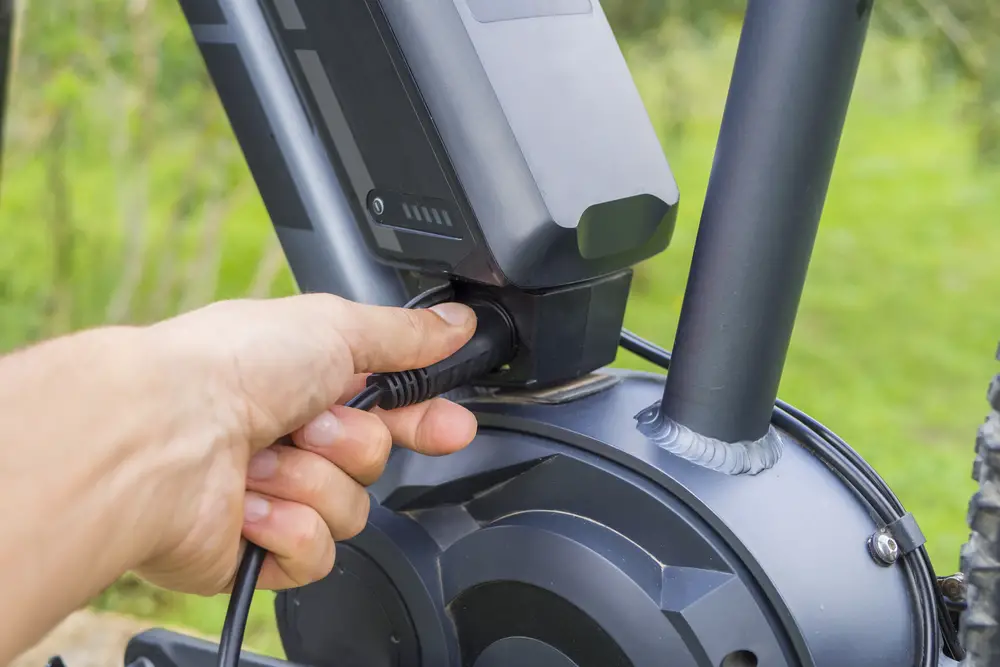Electric bicycles are rapidly becoming more popular across the nation and around the world. In many urban centers, it’s possible to rent e-bikes by the hour or for the day, but it’s impossible to control the quality of your ride when you go this route.
It’s also a fact that riding an e-bike is so much fun that a single rental experience might make you want to bring home your very own electric bicycle.
In most ways, electric bicycles are very similar to normal bicycles that are propelled with gears and pedals.
These motorized bikes are, however, outfitted with electronic components, and as is the case with all electronics purchases, it’s critically important that you choose the right parts as you construct your new electric bike.
You usually can’t change the motor that your electric bike is outfitted with, but you have much more control over the battery that is used to power this motor.
As you’ll discover in this guide, electric bike batteries vary widely in terms of power, quality, and durability, so choosing the right e bike battery will have a big impact on the quality of your ride.
Let’s dive into all the details in our guide to batteries for electric bikes, so you know all you need to know to pick a winner from the various electric bicycle batteries that are available on the market.
What Are Batteries For Electric Bikes?
Let’s start with the basics. An electric bicycle battery is a power source that is attached to the body of an electric bicycle to provide its motor with power.
Instead of being powered by pedals, electric bikes are powered by motors, so your electric bike will not operate without a sufficiently charged battery.
Electric bike batteries are generally designed to be small and lightweight while still providing as much power as possible.
Recent advancements in battery technology have made it possible to construct electric bike batteries that are smaller and more efficient than ever, and it’s expected that these batteries will only become more powerful over the next few years. In almost every case, electric bike batteries are rechargeable.
What Different Types Ff Batteries For Electric Bikes Are There?
There are quite a few important differences between the various types of e-bike batteries that we will discuss in this guide to batteries for electric bikes, that are available on the market.
As a result of these differences, some electric bike batteries are objectively superior to others, so it’s important to learn about the factors that vary among bike batteries to ensure that you make the right purchase:
Battery Type
Lithium-ion (Li-ion) batteries are the most common types of electric bike batteries on the market, but that doesn’t mean that Li-ion batteries are the only options offered.
Lithium-ion polymer (LiPo) batteries are also available, and the main advantage of this type of battery is its ability to be molded into practically any shape.
While traditional Li-ion batteries can only be made in oblong, rectangular shapes, LiPo batteries can be crafted to fit the contours of your electric bike.
It’s also possible to power electric bikes with outdated battery technologies like lead-acid batteries. In addition to being volatile and dangerous, however, lead-acid batteries are also incredibly bulky, and they have shorter lifespans compared to Li-ion and LiPo batteries.
Most importantly, lead-acid batteries are remarkably heavy, making them practically useless for electric bikes that are designed to be as lightweight as possible.
Volt Options
As you search through the various electric bike batteries available on the market, voltage will be one of the first factors you come across that varies among the options at your disposal.
In any electrical system, voltage is the variable that controls how much electricity can flow through a circuit, so voltage in electric bike batteries can generally be compared to horsepower in car engines.
Common voltage options in electric bike batteries include 24V, 36V, 48V, and 72V, and bike batteries with more voltage can supply greater amounts of electrical energy to your bike’s motor.
Keep in mind that bikes with 72V batteries are so powerful that they may not be classified as typical electric bicycles. Electric bike batteries that supply 36V or 48V are considered to be the norm.
Amp Options
If the voltage of your electric bike battery can be considered equivalent to horsepower in an engine, then the amps your bike provides can be considered equivalent to the amount of gas that’s in a car’s tank. The amount of amps that a battery provides is usually listed in amp-hours (Ah).
A bike battery that is listed as 10Ah, for instance, can provide 10 amperes of electrical power over the space of an hour. Most electric bikes will not use that much electricity in an hour, however, so that 10Ah of electrical power will most likely be used over the amount of time you ride your bike until its battery runs dry instead.
The amp-hour designation of an electric bike battery is generally used to determine the range of your bicycle. A variety of other factors can also affect the range of your bike, however, including terrain and the direction of ambient air currents.
Watt Hour Options
A watt-hour (Wh) is a unit of electrical energy that is used to determine the total amount of electrical energy contained in your bike battery.
As general units of electrical energy, watts are the result of multiplying volts by amps, so watt-hours are the result of multiplying volts by amp-hours.
For instance, if you have a 36V bike battery with 15Ah, then your battery has 540Wh. Watt-hours can also be used to determine the range of your electric bike battery, and Wh is more commonly used to denote an electric bike’s battery capacity than Ah.
Physical Sizes
In addition to all the factors we’ve listed above, electric bike batteries also vary in terms of physical size. While Li-ion batteries are the norm within the electric bike industry, these batteries vary widely in terms of quality and efficiency.
High-efficiency Li-ion batteries will generally be smaller than lower-quality alternatives, and the size of an Li-ion battery is also determined by its total electrical capacity.
For instance, it’s just as common to come across a high-quality Li-ion battery that’s huge because of its increased electrical capacity as it is to come across a low-quality battery that’s only big because of its inferior components.
LiPo batteries also vary in size, but these innovative batteries generally look smaller due to their contoured shapes.
Compatibility
Only certain types of batteries will be compatible with your electric bike.
In general, your bike will only be compatible with the type of battery it was originally designed to accommodate; a bike built for Li-ion batteries will not, for instance, be compatible with lead-acid batteries, which is why it is important to do your research and read comprehensive guides such as this one.
Most electric bikes are also only compatible with certain shapes and sizes of batteries. While the majority of electric bike batteries are constructed in a universal shape for maximum compatibility, it’s important to ensure that a battery you’re considering is compatible with your electric bike before you make a final decision.
How Do You Charge Batteries For Electric Bikes?
Now that we’ve covered the major differences between the various bike batteries in this guide to batteries for ebikes that are available on the market, it’s time to provide some guidance on how to use your new battery once it arrives.
In most cases, recharging and using electric bike batteries is simple and self-explanatory, but it’s still a good idea to be prepared.
The majority of electric bike batteries come with their own chargers. In some cases, it may be necessary to remove the battery from your bike for charging, but most electric bike chargers simply plug into your battery via the same port that is used to connect your battery to its motor.
The amount of time it takes to charge your bike depends mainly on two factors: the size of your battery and the transfer capacity of your charger.
The larger the capacity of your battery, the longer it will take to charge. Similarly, the charge time of your battery decreases conversely to the amount of electrical power that your charger can provide.
Once the battery in your electric bike has been fully charged, you can reconnect it to your bike’s motor and start riding. The majority of electric bike batteries have LED indicators that let you know when they are fully charged.

Do E-Bike Batteries Deteriorate Over Time?
Regardless of the type of battery you choose for your electric bike, your battery’s capacity will gradually deteriorate over time.
With our current level of technology, it’s simply impossible to make a battery that will last forever, which means that even the most powerful electric bike battery will eventually need to be replaced.
In general, lead-acid batteries deteriorate faster than Li-ion or LiPo batteries, but the lifespan of your battery ultimately depends on the quality of its construction.
Batteries deteriorate a certain amount per charge cycle, which is defined as a full depletion and recharging of a rechargeable battery.
If you ride your bike until its new battery is empty and then recharge your bike’s battery until it is full, for instance, your bike has now gone through a single charge cycle, and its maximum charge capacity has now been slightly reduced.
How Long Do E-Bike Batteries Last?
The amount of time that your battery will continue supplying power to your bike’s motor is determined by the voltage and amperage of the battery. Once it is depleted, you can only recharge your electric bike battery a certain number of times before it is no longer usable.
Generally speaking, Li-ion e-bike batteries can be recharged around 1,000 times, and lead-acid batteries can be recharged around 300 times.
Keep in mind that these estimates refer to the number of times that a battery can be fully recharged from a completely depleted state. If your battery has only been depleted halfway and you then charge it until it is full, you have only performed a partial recharge.
Each time that you deplete and recharge your battery, a small portion of the battery’s total capacity is lost. Therefore, even though your Li-ion electric bike battery will most likely still be viable after 500 recharges, it will only have approximately 50% of its original charge capacity.
Some e-bike owners choose to replace their batteries before they are fully unusable to enjoy the highest possible full-charge battery capacity.
How To Take Care Of Your Electric Bicycle Battery
While all electric batteries will lose their power capacity eventually, you can extend the life of your battery by caring for it properly. If you follow the steps we list below, your battery will last longer and retain its charge capacity better.
Keep Your Battery Charged
Li-ion and other types of batteries deteriorate slower when they are fully charged. Avoid entirely depleting your battery since empty batteries deteriorate faster, and make sure to charge your bike’s battery back to 100 percent even if you only rode your e-bike for a few minutes.
Keep Your Battery Clean, Cool, And Dry
Corrosion or dirt on the contacts of your battery will reduce its ability to power your electric bike’s motor. If you ride your bike in the rain, make sure to fully dry its battery before putting your bike away, and regularly inspect your bike battery’s contacts for any signs of rust or grime.
Also, it’s important to note that lithium batteries perform better when they are kept cool, so avoid exposing your bike battery to extreme heat.
Store Your Battery Properly When Not In Use
You’ll need to take special precautions if you don’t use your electric bike’s battery for a while.
Your battery will lose a portion of its total capacity if you store it when it is fully charged, but it will deteriorate even faster if it is stored when completely depleted. Charging your battery to around 80 percent before storage is a good compromise.
How To Pick An E Bike Battery
By this point, you’re an expert on what electric bike batteries are and how to maintain them. All that’s left is to find a battery that’s right for your bike. In this section, we’ll provide you with a few tips for picking a battery that will provide your electric bike with the exact type of power source it needs.
Type And Capacity
Unless you are making a custom electric bike, it’s likely that your e-bike is only compatible with a certain number of different battery types.
As you get ready to upgrade or replace your stock battery, make sure to check your bike’s user manual to ensure that you pick the right type of battery.
You certainly don’t want to choose a lead-acid battery when your bike is only compatible with Li-ion or LiPo power sources. As we’ve covered in this guide, however, not all types of lithium batteries are the same, so the battery you have your eye on might not work for your bike even if it’s very similar to your bike’s stock battery.
Also, make sure to pick a battery with the capacity necessary to propel your bike across the distances you have in mind.
Choose The Right Manufacturer
There are tons of different manufacturers of Li-ion and LiPo batteries, and you might find that multiple manufacturers make batteries that are compatible with your bike. Not all batteries are made equal, however, so it pays to pick the right manufacturer.
Generally speaking, batteries from big-name brands are more reliable and higher-quality. Brands like LG, Panasonic, and Sanyo all produce batteries for electric bikes, and these batteries usually come with warranties and comprehensive customer service.
Batteries made by brands you’ve never heard of, however, are riskier. There are plenty of cheap bike battery options made by shady Chinese brands, but there’s no way of knowing if these power units meet the quality and safety standards that bigger manufacturers follow.
Plus, you will likely have no recourse if a battery you buy from one of these generic brands fails or causes an injury.
Get Out There And Start Biking
Electric bikes have come a long way in the last decade or so. While it used to be necessary to lug a big, heavy battery around with you to enjoy the thrill of biking up a hill without pedalling, the wonders of lithium batteries have taken the electric bike industry light-years into the future.
If you want to go for a long ride, for instance, lithium batteries are so lightweight and compact that you can pack multiple batteries with you that you can switch out as you go.
New battery technologies have made electric biking an accessible and convenient hobby, but just remember to stay safe. Only choose batteries from brands you can trust, always follow the rules of the road, and never forget the most important rule of biking: Always wear a helmet!





